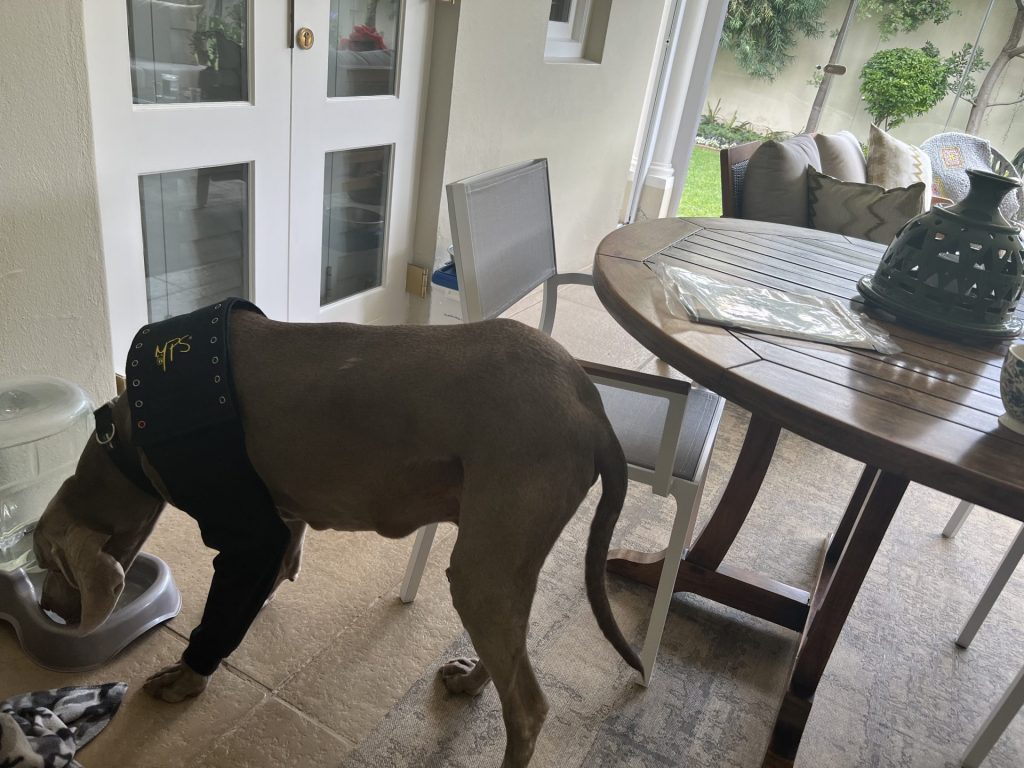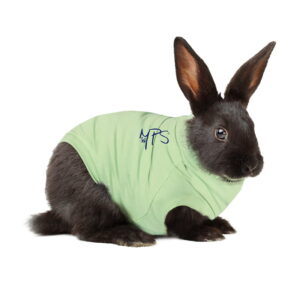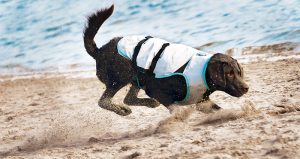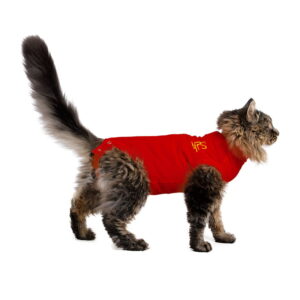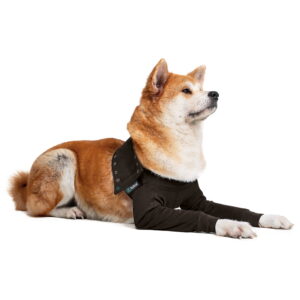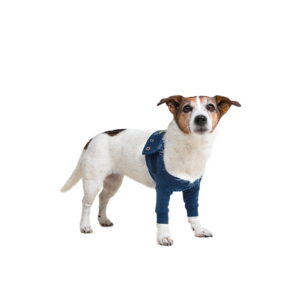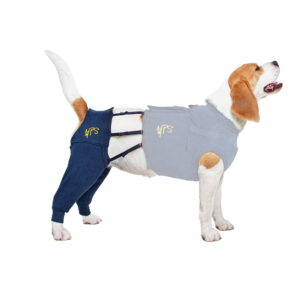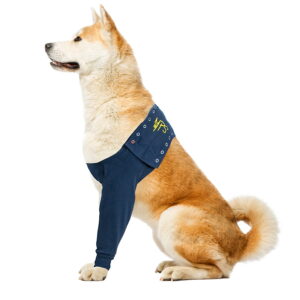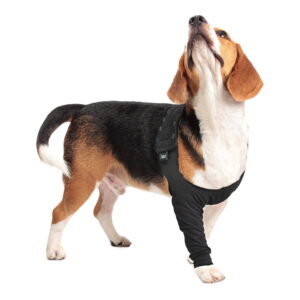Case Study: Treating a Dog’s Licking Granuloma (Acral Lick Dermatitis) with an MPS Paw Recovery Sleeve
If your dog keeps licking a paw raw and nothing seems to break the cycle, you are not alone. This case study follows Pablo, a large-breed Weimaraner in Johannesburg, who struggled for years with a chronic licking granuloma (also called acral lick dermatitis). After trying surgeries, antibiotics, and ointments, the turning point came when Pablo wore an MPS Single Paw Recovery Sleeve supplied by TailMe in South Africa.
At a glance: Pablo’s results
- Dog: Pablo, adult Weimaraner, large breed, active temperament
- Condition: Chronic licking granuloma on a front leg
- What had failed: Multiple surgeries, antibiotics, topical ointments, and the traditional cone
- Product used: MPS Single Paw Recovery Sleeve (front leg)
- Time to visible improvement: Within days, with steady progress over the following weeks
- Outcome: Licking cycle broken; wound finally able to heal without repeated flare-ups
- Supervised by: Dr JP, Johannesburg-based veterinarian
- SA availability: Yes, supplied by TailMe with countrywide delivery
Medical disclaimer: A recovery sleeve helps protect the area and block self-trauma. It does not replace veterinary diagnosis, infection control, or treatment of underlying causes such as allergies or pain. Always work with your vet.
What is a Licking Granuloma (Acral Lick Dermatitis)?
A licking granuloma is a circular, often infected wound caused by persistent licking and chewing. It commonly starts on a front leg but can occur anywhere a dog can reach. It is multifactorial and can be linked to:
- Allergies and skin irritation
- Pain in nearby joints or old injuries
- Stress, anxiety, boredom, or habit
- Secondary infection that fuels more licking
Once the cycle starts, it is hard to stop. The skin stays inflamed and moist, inviting infection and making the urge to lick even stronger.
Why cones often fail for chronic licking
The Elizabethan collar (cone) can help after surgery, but for long-standing licking it often falls short:
- Dogs can still reach a wrist or paw by bending around the edge
- Cones increase stress and reduce sleep and mobility for some dogs
- Friction from the cone can create new irritations and frustration
- Many determined lickers simply wait you out and resume as soon as the cone is off
If the goal is to calm the skin and make licking physically difficult and mentally unrewarding, a targeted barrier over the leg is often more effective.
How the MPS Single Paw Recovery Sleeve works
The MPS Paw Sleeve is a soft, breathable sleeve that covers the leg and paw while keeping the wound clean and off-limits.
- Targeted coverage blocks direct access to the lick site
- Stretch fabric moves with the leg for comfort during walks and rest
- Secure yet adjustable closures help keep the sleeve on
- Washable materials support daily hygiene and quick swaps between washes
- Available in sizes for small to giant breeds
Because it is gentler and more natural to wear than a cone, most dogs settle quickly and do not try to remove it.
Pablo’s healing timeline and results
Pablo had lived with a stubborn granuloma for years. According to Dr JP, a Johannesburg veterinarian involved in the trial, the MPS sleeve made the difference by breaking the lick reward loop and allowing the skin to repair itself:
- First few days: Licking attempts decreased markedly as the area stayed protected and less itchy
- By week 2: Noticeable reduction in redness and swelling; wound edges began to contract
- Following weeks: Healthy granulation and skin closure could progress without repeated trauma
Every dog is different, but the turning point came from consistent wear and proper fit. Once the licking habit was interrupted, healing could finally take hold.
Sizing and fit: how to measure your dog
Getting the right size is crucial for comfort and results.
Measure:
- Leg length: From the top of the leg where the sleeve will sit to just above the paw pad
- Circumference: Around the widest part of the forearm (or hock for hind leg)
- Paw size: If the sleeve includes an integrated paw cover, check your dog’s paw width
Fit tips:
- The sleeve should be snug but not tight; you should be able to slide two fingers under the fabric
- If between sizes, choose the fit that matches circumference first to prevent slipping
- Front vs hind: Front-leg sleeves have a slightly different shape than hind-leg options. Choose accordingly
Wear schedule, care, and cleaning
- Wear time: Keep the sleeve on consistently at first, including overnight, removing briefly for skin checks and cleaning as advised by your vet
- Walks and activity: Most dogs can walk and toilet normally; check fit after vigorous play
- Skin checks: At least twice daily in good light for any moisture build-up, discharge, or rubbing
- Cleaning the sleeve: Machine wash cold or hand wash with mild detergent; line dry; avoid fabric softeners and high heat to preserve elasticity
- Rotation: Having two sleeves allows for quick swaps and better hygiene
- Paw pads: If the paw is covered, keep nails trimmed and check frequently for dampness
If the fabric becomes damp or soiled, change it out. Dry, calm skin heals faster.
When to see a vet
Contact your vet if you notice:
- Increasing redness, swelling, or heat in the area
- Thick discharge or strong odour
- Pain when the area is touched
- Repeated chewing at the sleeve or signs of distress
- No improvement after 10 to 14 days of consistent protection
Granulomas often have contributing medical or behavioural causes. Your vet may suggest antibiotics, allergy management, pain control, or behaviour enrichment to help the sleeve do its best work.
FAQs
Q: What causes acral lick dermatitis in dogs?
A: It is commonly driven by allergies, pain, infection, anxiety, or boredom. Once the skin is damaged, licking becomes self-reinforcing. Treating both the wound and the underlying cause is key.
Q: Will a cone stop a licking granuloma?
A: Sometimes temporarily, but many dogs can still access the area or develop new irritations. A targeted leg sleeve is often a better long-term barrier for paw and wrist lesions.
Q: How long does a licking granuloma take to heal?
A: Early improvement can appear within days when licking stops. Deeper or long-standing lesions may take several weeks to months to fully resolve. Consistency and vet-guided care make the difference.
Q: Do recovery suits and sleeves help with hot spots and sutures?
A: Yes. They are widely used to protect hot spots, surgical sites, and stitches, and to prevent self-trauma while the skin recovers.
Q: Can my dog sleep in a recovery sleeve?
A: Yes. Most dogs sleep better in a soft sleeve than with a hard cone. Check fit and the skin before bed and again in the morning.
Q: How do I choose the correct size for front vs hind legs?
A: Measure circumference and length and select the product designed for the specific leg. If you are unsure, share your measurements and a photo with our team for a quick recommendation.
Q: Will a sleeve replace antibiotics or vet treatment?
A: No. It protects the area and breaks the habit, but infection, allergies, and pain still need diagnosis and treatment from your vet.
Shop Medical Recovery and Sleeves
Speak to TailMe: 010 007 1717 or info@tailme.co.za
SA delivery and returns: Countrywide courier delivery, secure local payment methods.
TailMe is the South African distributor of Medical Pet Shirts (MPS) and a specialist in pet recovery solutions. Questions about fit or care? We are happy to help.
